More Apple Varieties
Choosing apples to recommend is like trying to choose
between your children. Any of these apples could have made it to
our first list, and are only relegated to this second list because they
are not as disease-resistant. Some of these may not be as pretty as those on our primary
list or have some marketing flaw, but still have qualities that make
them a valuable addition to any orchard. The taste will still beat
any import you find in the market. |
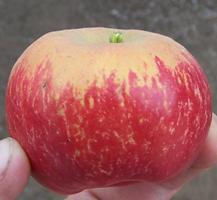 Cinnamon
Spice California,
recent
Discovered by Jesse Schwartz, Cinnamon
Spice is named after the rich cinnamon taste it purportedly has. In
our climate it was juicy and sweet, but we couldn't detect even a hint
of cinnamon, which might have to do with our lack of cold nights while
it is ripening. The skin is a green base with a beautiful red and
orange blush and russeting at the top. Flesh is whitish yellow and
fine, dense, moderately juicy, slightly chewy. It bore heavily and held
up well in the heat. Cinnamon
Spice California,
recent
Discovered by Jesse Schwartz, Cinnamon
Spice is named after the rich cinnamon taste it purportedly has. In
our climate it was juicy and sweet, but we couldn't detect even a hint
of cinnamon, which might have to do with our lack of cold nights while
it is ripening. The skin is a green base with a beautiful red and
orange blush and russeting at the top. Flesh is whitish yellow and
fine, dense, moderately juicy, slightly chewy. It bore heavily and held
up well in the heat. |
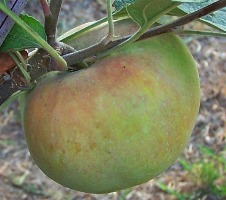 Coconut
Crunch Idaho, USA, Recent Bred by apple aficionado and
all-round nice guy Garfield Shults, Coconut Crunch is an extremely solid
apple that ripens fairly late, though it's hard to tell when it's ripe
because you don't use it until it has been in storage a while. It has
absolutely no coconut taste, the name came from the firm texture.
It’s been known to keep for a full year in ordinary cold storage.
A yellow apple with a sweet, spicy, classic apple flavor that bears heavily every season. Coconut
Crunch Idaho, USA, Recent Bred by apple aficionado and
all-round nice guy Garfield Shults, Coconut Crunch is an extremely solid
apple that ripens fairly late, though it's hard to tell when it's ripe
because you don't use it until it has been in storage a while. It has
absolutely no coconut taste, the name came from the firm texture.
It’s been known to keep for a full year in ordinary cold storage.
A yellow apple with a sweet, spicy, classic apple flavor that bears heavily every season. |
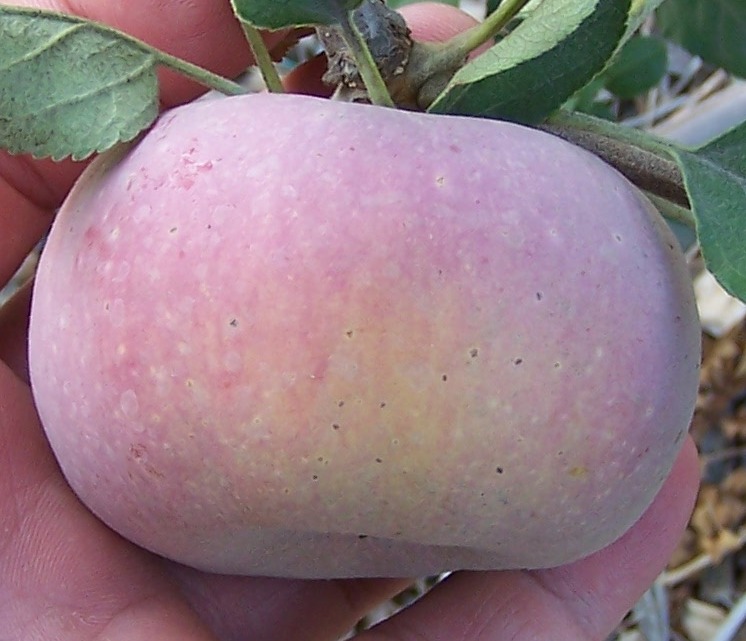 Crimson
Gold California, USA, 1944 The Crimson Gold apple is the
last of dozens of American apple varieties developed by fruit breeder,
Albert Etter. Etter was fascinated with crab apples and chose to
hybridize an entire class of apples specifically from crab parentage.
The difference, though, is that, unlike crab apples, these apples would
lack astringency, rather display a blend of both high acid and high
sugar content. The Crimson Gold, originally named by Etter, Little
Rosybloom, was introduced to the public in 1944. Etter died in 1950,
before the fruit's patent paperwork was finalized. The Crimson Gold
orchards were under ownership of the California Nursery Company and
somehow trees were being mislabeled, grown and distributed as Wickson
apples (another crab apple variety). It wasn't until the late 1970's
that a single limb of a multi-grafted test tree was identified as
Crimson Gold and the variety was saved from near extinction. Crimson
Gold apples still remain an unpatented variety. They ripened early
November this year for us and got pretty big, and were of excellent
quality and nice color. Crimson
Gold California, USA, 1944 The Crimson Gold apple is the
last of dozens of American apple varieties developed by fruit breeder,
Albert Etter. Etter was fascinated with crab apples and chose to
hybridize an entire class of apples specifically from crab parentage.
The difference, though, is that, unlike crab apples, these apples would
lack astringency, rather display a blend of both high acid and high
sugar content. The Crimson Gold, originally named by Etter, Little
Rosybloom, was introduced to the public in 1944. Etter died in 1950,
before the fruit's patent paperwork was finalized. The Crimson Gold
orchards were under ownership of the California Nursery Company and
somehow trees were being mislabeled, grown and distributed as Wickson
apples (another crab apple variety). It wasn't until the late 1970's
that a single limb of a multi-grafted test tree was identified as
Crimson Gold and the variety was saved from near extinction. Crimson
Gold apples still remain an unpatented variety. They ripened early
November this year for us and got pretty big, and were of excellent
quality and nice color. |
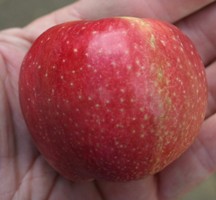 Cripp's
Pink Australia, 1979 Cripp's Pink apples that are grown to
certain quality standards are marketed under the Pink Lady®
trademarked name. A cross between Lady Williams and Golden Delicious,
it is a favorite in supermarkets because of it's dense, crisp juicy
flesh and sweet-tart flavor. It is not bothered in the least by hot
weather and even excels in the deserts of Las Vegas and Phoenix, once
considered apple graveyards because of their intense heat (46C.).
For tropic climates, its relatives Lady Williams and Cripp's -Two
are more suited, but it is still worthwhile to grow. Cripp's
Pink Australia, 1979 Cripp's Pink apples that are grown to
certain quality standards are marketed under the Pink Lady®
trademarked name. A cross between Lady Williams and Golden Delicious,
it is a favorite in supermarkets because of it's dense, crisp juicy
flesh and sweet-tart flavor. It is not bothered in the least by hot
weather and even excels in the deserts of Las Vegas and Phoenix, once
considered apple graveyards because of their intense heat (46C.).
For tropic climates, its relatives Lady Williams and Cripp's -Two
are more suited, but it is still worthwhile to grow. |
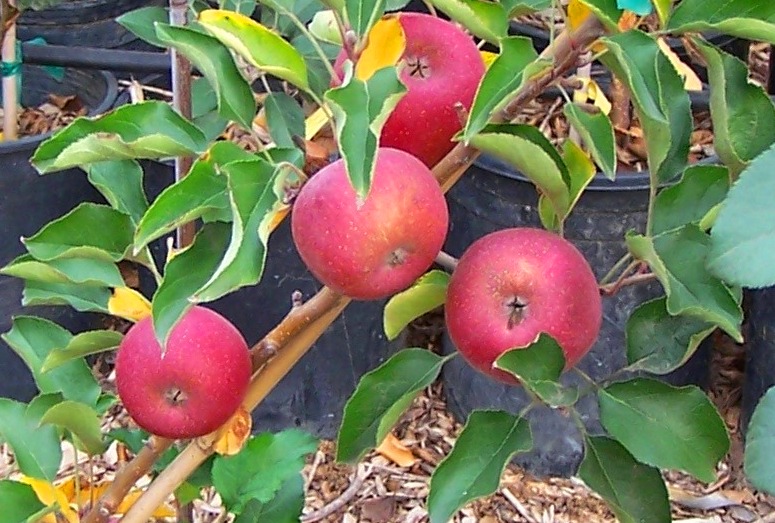
Cripp's-Two Australia, 1973 Also known
as its trademarked name Sundowner™, Cripps-Two is a cross
between Lady Williams and Golden Delicious and is a popular commercial
variety in Australia and England. It ripens very late in the season,
and needs a long hot season to be its best. It is considered low-chill
and sets fruit very reliably, even when a tiny tree, and is very sun and
heat resistant. The flavor is a pleasing sweet-tart and the texture is
firm. It has a red skin on a yellow background. |
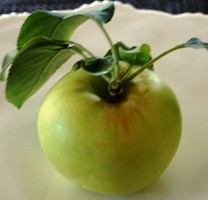 Hawaii
California, USA, 1945 This beautiful, large, yellow apple is
exceptionally sweet (even when green), but we can't taste any pineapple.
The fruit is a pale green and is considered one of the very best dessert
apples, and eating them fresh is a real treat (children love them. A
vigorous grower that ripens lmid-season, tends to bear biannually. Thin
heavily for best results. Hawaii
California, USA, 1945 This beautiful, large, yellow apple is
exceptionally sweet (even when green), but we can't taste any pineapple.
The fruit is a pale green and is considered one of the very best dessert
apples, and eating them fresh is a real treat (children love them. A
vigorous grower that ripens lmid-season, tends to bear biannually. Thin
heavily for best results. |
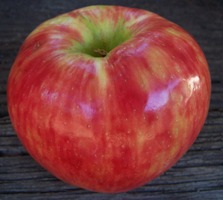 Honeycrisp
University of Minnesota, USA, 1962 Many growers hate this tree
as it has some serious problems like lack of vigor, cracking on the top,
bitter pit, bruising, and yellowing leaves. Yet they are pulling
out other trees to plant more Honeycrisp, and for good reason; they are
getting between $60-$70 USD a box wholesale in the USA, with individual
apples selling for $1.62 USD in some markets, which would buy you a
whole kilo of Red Delicious. The reason is the crunch; kind of
like a cross between watermelon and an apple, and the flavor,
super-sweet that has kids preferring them over candy. 20 years
after the release the patent has ran out but the demand is still
growing. It is a fussy tree that needs to be "starved to
perfection, preferring low organic matter soils and careful training.
But if you're able to coax it to produce a few apples, you'll see what
all the fuss is about and we guarantee you'll try to find out how to
grow more. It has good pollen and is partly self-fertile, and will
pollinate other trees. Honeycrisp
University of Minnesota, USA, 1962 Many growers hate this tree
as it has some serious problems like lack of vigor, cracking on the top,
bitter pit, bruising, and yellowing leaves. Yet they are pulling
out other trees to plant more Honeycrisp, and for good reason; they are
getting between $60-$70 USD a box wholesale in the USA, with individual
apples selling for $1.62 USD in some markets, which would buy you a
whole kilo of Red Delicious. The reason is the crunch; kind of
like a cross between watermelon and an apple, and the flavor,
super-sweet that has kids preferring them over candy. 20 years
after the release the patent has ran out but the demand is still
growing. It is a fussy tree that needs to be "starved to
perfection, preferring low organic matter soils and careful training.
But if you're able to coax it to produce a few apples, you'll see what
all the fuss is about and we guarantee you'll try to find out how to
grow more. It has good pollen and is partly self-fertile, and will
pollinate other trees. |
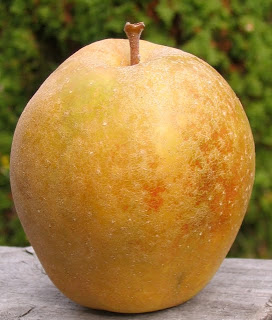 Hudson's
Golden Gem Oregon, USA, 1931 Discovered in a fencerow
thicket in Oregon and was introduced in 1931 by the Hudson Wholesale
Nurseries of Tangent, Oregon. It is probably the largest-size,
high-quality russet apple. It has pronounced conical shape, smooth,
uniformly dull-russet skin, a very long stem and sugary, juicy, crisp
flesh. The flesh is light yellow in color. In our climate, the shape is
irregular with a knob on the bottom resembling a hot-air balloon. It is
a vigorous, productive and annual bearer. In taste tests, the flavor has
been described as pear-like and nutty. The tree remains small, even on
seedling rootstock, and the fruit will hang on the tree long into the
winter. There is a tendency to biennial production, and
cross-pollination will increase the fruitfulness. Hudson's Golden Gem
will store well and ripens in mid- September. It can be a beautiful
apple for a russet. Holds up well to our heat Hudson's
Golden Gem Oregon, USA, 1931 Discovered in a fencerow
thicket in Oregon and was introduced in 1931 by the Hudson Wholesale
Nurseries of Tangent, Oregon. It is probably the largest-size,
high-quality russet apple. It has pronounced conical shape, smooth,
uniformly dull-russet skin, a very long stem and sugary, juicy, crisp
flesh. The flesh is light yellow in color. In our climate, the shape is
irregular with a knob on the bottom resembling a hot-air balloon. It is
a vigorous, productive and annual bearer. In taste tests, the flavor has
been described as pear-like and nutty. The tree remains small, even on
seedling rootstock, and the fruit will hang on the tree long into the
winter. There is a tendency to biennial production, and
cross-pollination will increase the fruitfulness. Hudson's Golden Gem
will store well and ripens in mid- September. It can be a beautiful
apple for a russet. Holds up well to our heat |
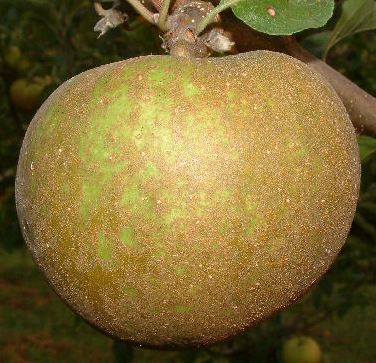
Junaluska
North Carolina, USA, 1830 Discovered by
an American Indian chief named Junaluska.
It's
a large to very large, high-quality apple with a distinctive irregular
globular form. The dull yellow skin is somewhat rough with raised russet
patches, occasional greenish spots and with a pale red flush on the
sunny side. The tender yellow flesh is juicy,
rich, and very sweet with a pleasant subacid flavor.
Good for
dehydrating, as the apples are huge and easy to peel. An
old-fashioned apple from a different era. |
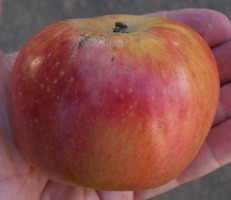 Nittany
Pennsylvania, USA, recent Introduced by Penn State
University, a cross between York Imperial and Golden Delicious. This
year we've been impressed by this high-quality apple and added it to our
"favorites" list Skin is a dull red color and may become "greasy" as
they mature. Flesh is yellow and firm with a sweet-tart flavor and one
of the nicest "crunches" in the orchard. Ripens in October, and will
store for up to six months. Bears very heavily but tends to drop before
they are ripe. Nittany
Pennsylvania, USA, recent Introduced by Penn State
University, a cross between York Imperial and Golden Delicious. This
year we've been impressed by this high-quality apple and added it to our
"favorites" list Skin is a dull red color and may become "greasy" as
they mature. Flesh is yellow and firm with a sweet-tart flavor and one
of the nicest "crunches" in the orchard. Ripens in October, and will
store for up to six months. Bears very heavily but tends to drop before
they are ripe. |
| |
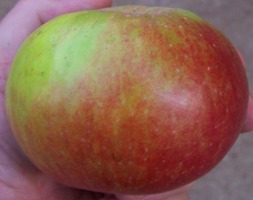 Red
Boskoop Netherlands, 1850 An apple for people who like their
apple to bite back, it has an intense sweet-tart flavor that needs to be
dead ripe to be best. The whitish-green flesh is firm and
dense. It keeps its shape when baked into a pie, and can be used as the
"sharp" ingredient for cider. It supposedly improves in storage, which
we may never find out as I can tell we'll be eating these. I bet it
would make a killer pie. Red
Boskoop Netherlands, 1850 An apple for people who like their
apple to bite back, it has an intense sweet-tart flavor that needs to be
dead ripe to be best. The whitish-green flesh is firm and
dense. It keeps its shape when baked into a pie, and can be used as the
"sharp" ingredient for cider. It supposedly improves in storage, which
we may never find out as I can tell we'll be eating these. I bet it
would make a killer pie. |
| |
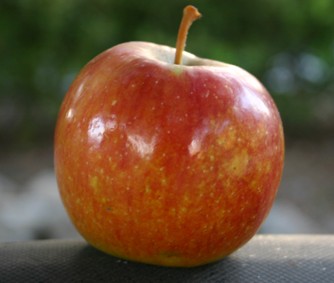 Wealthy
Minnesota, USA 1868 One of the most cold-hardy apples that is
also low-chill, popular for growing in tropical climates. Breeder Peter
Gideon named it after his wife with the odd name of Wealthy, as he said
it shared some of her same qualities; beauty, grace, and faithfulness in
the middle of a harsh wilderness. Flesh whitish sometimes stained
with red, tender, very juicy, flavorful sweet subacid, makes good pies. Wealthy
Minnesota, USA 1868 One of the most cold-hardy apples that is
also low-chill, popular for growing in tropical climates. Breeder Peter
Gideon named it after his wife with the odd name of Wealthy, as he said
it shared some of her same qualities; beauty, grace, and faithfulness in
the middle of a harsh wilderness. Flesh whitish sometimes stained
with red, tender, very juicy, flavorful sweet subacid, makes good pies.
|
| |
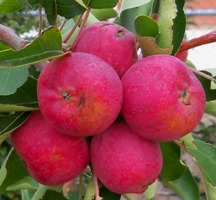 Wickson
Crabapple California, USA 1930's An Albert Etters hybrid
named after Edward J. Wickson, who was called the "Father of California
Agriculture" and a mentor to Etters and Luther Burbank. People see this
tiny little red and gold apple and think they are cute, until they bite
into it and see it has a great big apple taste and then eat it down the
to a tiny core. Originally bred for cider, the crisp,
yellow-fleshed golf ball-sized apples pack a lot of flavor into a small
package, and excel in making flavorful cider, both sweet and hard.
They're also good for eating out of hand, and like most sweet
crabapples, bear heavily and do quite well in a warm climate. Wickson
Crabapple California, USA 1930's An Albert Etters hybrid
named after Edward J. Wickson, who was called the "Father of California
Agriculture" and a mentor to Etters and Luther Burbank. People see this
tiny little red and gold apple and think they are cute, until they bite
into it and see it has a great big apple taste and then eat it down the
to a tiny core. Originally bred for cider, the crisp,
yellow-fleshed golf ball-sized apples pack a lot of flavor into a small
package, and excel in making flavorful cider, both sweet and hard.
They're also good for eating out of hand, and like most sweet
crabapples, bear heavily and do quite well in a warm climate. |
| |
| We have many more varieties on hand and
hundreds more we can order; if you have your heart set on something
we can usually custom-graft it for you. Who knows, maybe your
selection will do well in the tropics and start a whole industry. |
| |
|
Home
|
Order Form |
Contact Us |
| |
|
©2015 Kuffel Creek |
| |
| |
| |

 Hudson's
Golden Gem Oregon, USA, 1931 Discovered in a fencerow
thicket in Oregon and was introduced in 1931 by the Hudson Wholesale
Nurseries of Tangent, Oregon. It is probably the largest-size,
high-quality russet apple. It has pronounced conical shape, smooth,
uniformly dull-russet skin, a very long stem and sugary, juicy, crisp
flesh. The flesh is light yellow in color. In our climate, the shape is
irregular with a knob on the bottom resembling a hot-air balloon. It is
a vigorous, productive and annual bearer. In taste tests, the flavor has
been described as pear-like and nutty. The tree remains small, even on
seedling rootstock, and the fruit will hang on the tree long into the
winter. There is a tendency to biennial production, and
cross-pollination will increase the fruitfulness. Hudson's Golden Gem
will store well and ripens in mid- September. It can be a beautiful
apple for a russet. Holds up well to our heat
Hudson's
Golden Gem Oregon, USA, 1931 Discovered in a fencerow
thicket in Oregon and was introduced in 1931 by the Hudson Wholesale
Nurseries of Tangent, Oregon. It is probably the largest-size,
high-quality russet apple. It has pronounced conical shape, smooth,
uniformly dull-russet skin, a very long stem and sugary, juicy, crisp
flesh. The flesh is light yellow in color. In our climate, the shape is
irregular with a knob on the bottom resembling a hot-air balloon. It is
a vigorous, productive and annual bearer. In taste tests, the flavor has
been described as pear-like and nutty. The tree remains small, even on
seedling rootstock, and the fruit will hang on the tree long into the
winter. There is a tendency to biennial production, and
cross-pollination will increase the fruitfulness. Hudson's Golden Gem
will store well and ripens in mid- September. It can be a beautiful
apple for a russet. Holds up well to our heat
 Nittany
Pennsylvania, USA, recent Introduced by Penn State
University, a cross between York Imperial and Golden Delicious. This
year we've been impressed by this high-quality apple and added it to our
"favorites" list Skin is a dull red color and may become "greasy" as
they mature. Flesh is yellow and firm with a sweet-tart flavor and one
of the nicest "crunches" in the orchard. Ripens in October, and will
store for up to six months. Bears very heavily but tends to drop before
they are ripe.
Nittany
Pennsylvania, USA, recent Introduced by Penn State
University, a cross between York Imperial and Golden Delicious. This
year we've been impressed by this high-quality apple and added it to our
"favorites" list Skin is a dull red color and may become "greasy" as
they mature. Flesh is yellow and firm with a sweet-tart flavor and one
of the nicest "crunches" in the orchard. Ripens in October, and will
store for up to six months. Bears very heavily but tends to drop before
they are ripe. Red
Boskoop Netherlands, 1850 An apple for people who like their
apple to bite back, it has an intense sweet-tart flavor that needs to be
dead ripe to be best. The whitish-green flesh is firm and
dense. It keeps its shape when baked into a pie, and can be used as the
"sharp" ingredient for cider. It supposedly improves in storage, which
we may never find out as I can tell we'll be eating these. I bet it
would make a killer pie.
Red
Boskoop Netherlands, 1850 An apple for people who like their
apple to bite back, it has an intense sweet-tart flavor that needs to be
dead ripe to be best. The whitish-green flesh is firm and
dense. It keeps its shape when baked into a pie, and can be used as the
"sharp" ingredient for cider. It supposedly improves in storage, which
we may never find out as I can tell we'll be eating these. I bet it
would make a killer pie.